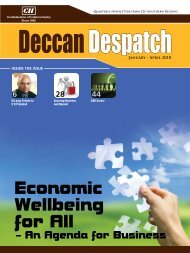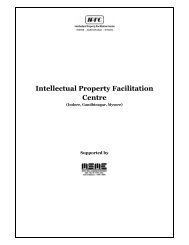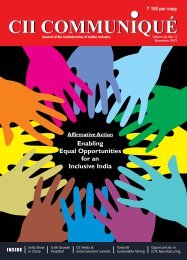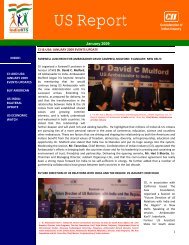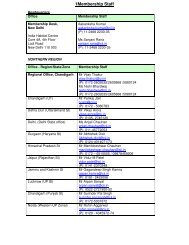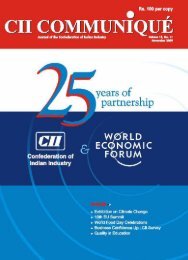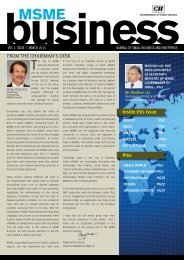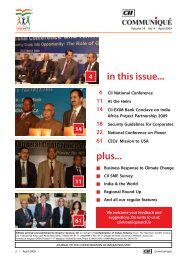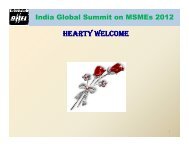CII Communique - December, 2010
CII Communique - December, 2010
CII Communique - December, 2010
You also want an ePaper? Increase the reach of your titles
YUMPU automatically turns print PDFs into web optimized ePapers that Google loves.
economy<br />
review<br />
Second Quarter Review of the<br />
Monetary Policy <strong>2010</strong><br />
The RBI’s second quarter review of monetary<br />
policy has been influenced by the mixed indications of<br />
persistent sluggishness in the advanced economies and<br />
positive signals emanating from the Emerging Market<br />
Economies (EMEs). The weak recovery and large<br />
unemployment in advanced economies have raised<br />
concerns about the sustainability of the global recovery.<br />
It has led to the downward revision of world GDP growth<br />
by the IMF to 4.2% in 2011 as compared with 4.8% in<br />
<strong>2010</strong>. The second round of quantitative easing by the<br />
advanced economies to further stimulate private demand<br />
has increased the risk for EMEs, including India of<br />
receiving high capital inflows and firming up of global<br />
commodity prices.<br />
On the domestic front, the monetary policy stance<br />
has been influenced by persistently high inflation.<br />
Headline inflation remained significantly above the<br />
RBI’s medium-term target notwithstanding some<br />
recent moderation. Food inflation has declined only<br />
moderately post-monsoon, as inflation in protein-rich<br />
items such as pulses and eggs, meat and fish, has<br />
remained high. Although primary food inflation plunged<br />
from 21.4% in May <strong>2010</strong> to 15.7% in September <strong>2010</strong>,<br />
it still remained elevated. Inflation in non-food items<br />
(excluding food products and food articles) rose sharply<br />
from -2.9% in September 2009 to 7.8% in September<br />
<strong>2010</strong> and in non-food manufactured products from<br />
-2.0% to 5.0%.<br />
The RBI has stated that inflation in the second half of<br />
the current fiscal will be shaped by:<br />
• Evolution of food inflation<br />
• Movements in global commodity prices<br />
• Potential build up in the demand side pressure with<br />
sustained growth resulting in capacity constraints in<br />
many industries<br />
On the basis of current trends, the RBI has maintained<br />
its baseline projection for WPI inflation for <strong>2010</strong>-11<br />
unchanged at 6.0% according to the old series; and<br />
5.5% as per the new series. Given the present slow<br />
down in industrial growth and inflation trends, the RBI<br />
has indicated that the possibility of a further hike in<br />
policy rates in the immediate future is remote.<br />
In order to contain inflationary expectation, the RBI has<br />
further raised the repo and reverse repo rates by 25<br />
basis points each to 6.25% and 5.25% respectively in<br />
the second quarter policy. Liquidity has become tighter<br />
and the Reserve Bank has been a net lender in the LAF<br />
since September.<br />
Surplus / Deficit in Liquidity Adjustment<br />
Facility (Rs crore)<br />
Inflation Rate (Y-o-Y)<br />
Source: CMIE and RBI<br />
* Data is from 1- 16 November <strong>2010</strong><br />
Source: CMIE<br />
The growth in money supply (M3) remained subdued<br />
at 15.2% on 8 October <strong>2010</strong> compared to the target<br />
of 17.0% for <strong>2010</strong>-11. This lower growth in M3 can<br />
be attributed to the sluggishness in deposits growth<br />
(particularly long term deposits). This has resulted<br />
14 | <strong>December</strong> <strong>2010</strong> Communiqué



